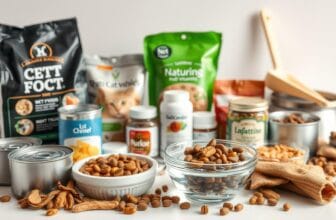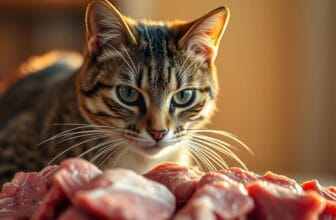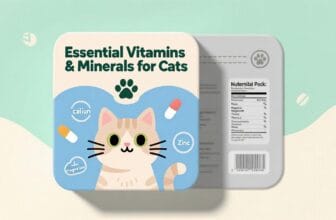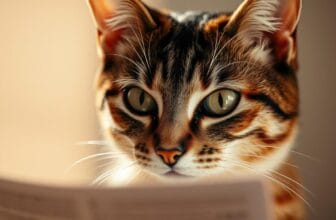
Table of Contents
Would you feed your cat like their wild ancestors? Raw cat food diets are a big topic among pet owners and vets. They wonder if it’s the best way to feed cats.
Cats are meat-eaters and need certain nutrients that other pets don’t. The raw diet tries to match what wild cats eat. It offers unprocessed, rich meals that might be better than regular cat food.
In this guide, we’ll look at the good and bad of raw diets for cats. You’ll learn if it’s good for your cat’s health and nutrition.
Learning about raw diets is important. It’s about knowing what your cat needs and making choices that help their health for a long time.
Understanding Raw Cat Food Diets: An Overview
Exploring raw meat diets for cats is fascinating. Cats are natural meat-eaters with special needs. The raw diet movement is growing, as pet owners want to give their cats more natural food.
Those interested in the BARF diet have many choices. These diets try to match what wild cats eat, focusing on whole foods.
What Constitutes a Raw Diet for Cats
A typical raw diet includes:
- Fresh muscle meat
- Raw organ meats
- Uncooked bones
- Small amounts of vegetation
Historical Context of Feline Raw Feeding
Wild cats have always eaten raw prey. This idea led to the modern raw cat food movement. Domesticated cats still need the same nutrition, making raw diets a popular choice for health-conscious owners.
Types of Raw Food Options Available
Pet owners have several commercial raw cat food options:
- Frozen raw meals
- Freeze-dried raw options
- Dehydrated raw preparations
- Homemade raw food recipes
Each option has its own benefits. Cat owners can pick what works best for their lifestyle and their cat’s needs.
The Science Behind Raw Cat Food Diet
Raw diets are becoming more popular among cat owners. This is because cats have a unique digestive system. They need a diet rich in animal protein to stay healthy.
Cats are designed to eat meat. Their short, acidic digestive tract is great for breaking down raw animal proteins. This helps them get the most nutrients from unprocessed meat.
- Cats metabolize protein as their primary energy source
- Raw diets mirror their natural ancestral eating patterns
- Protein bioavailability is higher in unprocessed foods
Nutritional research shows why raw diets are good for cats:
| Nutritional Aspect | Raw Diet Benefit |
|---|---|
| Protein Absorption | Higher digestibility |
| Nutrient Density | Minimally processed nutrients |
| Moisture Content | Improved hydration |
Veterinary nutritionists are studying raw diets for cats. They find that a well-balanced raw diet can be very beneficial for their health.
Natural Feline Nutrition Requirements
It’s key to know what your cat needs to stay healthy. Cats are special meat-eaters with needs that are different from other pets. They need a balanced diet to thrive.
Cats need lots of good protein to keep their bodies working right. Their protein needs are higher than many other animals. This makes protein very important for them.
Essential Nutrients for Optimal Health
Your cat’s diet should have important parts for complete nutrition:
- High-quality animal protein
- Essential amino acids like taurine
- Specific fatty acids
- Critical vitamins and minerals
Critical Protein Components
Cats need more than just meat. They need special amino acids that their bodies can’t make. Taurine is key for heart health, vision, and more.
Vitamin and Mineral Essentials
Cats also need special vitamins and minerals for health:
- Vitamin A for eye health
- Vitamin D for bone strength
- B-complex vitamins for metabolism
- Calcium and phosphorus for skeletal development
Meeting these needs helps your cat stay healthy. This is true for raw diets or commercial foods.
Commercial vs. Homemade Raw Food Options
Pet owners must decide between commercial and homemade raw cat food. Each option has its own benefits and challenges. It’s important to think carefully about what’s best for your cat.
Commercial raw cat food has several advantages:
- It’s nutritionally balanced by experts.
- It comes in convenient packaging.
- The ingredients are consistently high quality.
- It saves time on preparation.
Homemade cat food, on the other hand, lets you customize your cat’s diet. You can choose the ingredients and adjust the recipes to meet your cat’s needs. Veterinary nutritionists suggest working with experts to create homemade raw diets.
“The key to successful raw feeding is ensuring complete nutritional balance” – Veterinary Nutrition Expert
When choosing commercial raw cat food, look at these important factors:
- Check if it meets AAFCO’s nutritional standards.
- Look at where the ingredients come from.
- Ensure the manufacturing meets high standards.
- Make sure it matches your cat’s nutritional needs.
Your decision between homemade and commercial raw cat food depends on your time, budget, and willingness to research nutrition. Talking to a veterinary nutritionist can help you make the best choice for your cat.
Benefits of Feeding Raw Food to Cats
Cat owners are finding health benefits in raw diets for their pets. These diets are becoming popular for improving cat health naturally. They offer many advantages for your cat’s overall well-being.
Many pet owners see big improvements when they switch to raw food. The benefits touch on many areas of feline health:
Improved Digestion
Raw diets help your cat’s digestive system in several ways:
- Smaller, more compact stools
- Reduced litter box odor
- Enhanced nutrient absorption
- More natural digestive process
Dental Health Advantages
Cats on raw diets often have better dental health:
- Reduced tartar buildup
- Cleaner teeth
- Healthier gum condition
- Natural teeth cleaning through raw meat consumption
Coat and Skin Health
Raw diets also improve your cat’s external health:
- Shinier, more lustrous coat
- Reduced skin irritations
- Improved skin hydration
- Potential reduction in allergic reactions
While many owners report positive outcomes, it’s crucial to consult with a veterinary professional before making significant dietary changes for your cat.
Potential Risks and Safety Concerns

Thinking about a raw food diet for your cat? It’s important to know the risks. Veterinary groups have big concerns about cat food safety. Every pet owner should think carefully about this.
The main risks include:
- Bacterial contamination from uncooked meats
- Potential nutritional imbalances
- Risk of parasitic infections
- Potential choking hazards from bone fragments
Health organizations like the CDC and FDA warn against raw diets. People with weak immune systems, young kids, and the elderly are at higher risk.
Keeping your cat safe with raw diets is tough. Bacteria like Salmonella, E. coli, and Listeria can be in raw meat. This is a big health risk for cats and people. It’s key to handle food right and keep things clean.
“The risks of raw diets often don’t match the benefits,” say vet nutrition experts.
Your cat’s health is most important. Talking to a vet can help you decide if a raw diet is right for your pet.
Bacterial Contamination and Food Safety
Raw cat food diets come with unique challenges. It’s important to know the risks and follow proper hygiene practices. This helps keep your cat and family safe from health hazards.
Raw meat can carry dangerous bacteria. These bacteria can harm both cats and humans. It’s crucial to handle raw meat carefully to avoid infections.
Common Pathogens in Raw Cat Food
- Salmonella: A dangerous bacteria that can cause severe digestive issues
- E. coli: Potentially life-threatening bacterial strain
- Listeria: Another serious food-borne pathogen
- Campylobacter: Less known but equally dangerous microorganism
Prevention Methods for Food Safety
To protect your cat from harmful bacteria, you need to take several steps:
- Always buy raw food from trusted sources
- Use separate cutting boards for raw meat
- Thoroughly clean food preparation surfaces
- Wash your hands before and after handling raw food
Safe Handling Practices
Following strict hygiene protocols is key. Keep raw cat food refrigerated and use clean utensils. Also, avoid mixing raw meat with other foods to prevent contamination.
Proper handling and storage can greatly reduce the risk of bacterial transmission in raw cat diets.
By understanding the risks and following prevention strategies, you can ensure your cat gets the benefits of a raw diet. This way, you can also minimize health dangers.
Nutritional Balance in Raw Diets
Creating a balanced cat nutrition plan with raw diets needs careful thought. Raw meat alone can’t cover all your cat’s needs. Cats need a diet rich in more than just protein.
To ensure your cat gets the right nutrition, you must add several key items:
- Organ meats for essential vitamins
- Bone meal or calcium supplements
- Taurine-rich ingredients
- Trace minerals
Raw diet supplements are vital for filling nutritional gaps. Professional vets suggest specific guidelines to avoid deficiencies. Your raw diet must meet AAFCO standards for complete nutrition.
Key nutrients to focus on include:
- Taurine: Essential for heart and eye health
- Calcium: Critical for bone strength
- Vitamin A: Supports immune function
- Omega fatty acids: Promote skin and coat health
Getting advice from a vet nutritionist is key. They can help craft a raw diet tailored to your cat’s needs. Remember, every cat is different, based on age, weight, and health.
Guidelines for Transitioning to Raw Food
Switching your cat to a raw diet needs careful planning and patience. The transition can be tough, but with the right steps, you can help your cat thrive. This change supports their nutritional needs.

Before starting the cat food change, talk to your vet. They can check if the raw diet fits your cat’s health needs. Some cats might need special diets.
Gradual Transition Steps
- Start by adding small amounts of raw food to their current diet
- Slowly increase the raw food over 7-10 days
- Watch how your cat reacts to the new diet
- Keep their feeding schedule consistent
Monitoring Your Cat’s Response
Keep an eye on these key signs during the transition:
- Digestive changes – Look for normal stool consistency
- Energy levels
- Coat and skin health
- Overall appetite
If your cat shows big negative signs, slow down the transition. Or, talk to your vet. Some cats need more time to adjust to raw food.
Patience is key when introducing a new diet to your feline companion.
Remember, every cat is different. The transition to raw food may take longer for some. Be attentive and flexible during the change.
Storage and Handling of Raw Cat Food
Storing raw cat food right is key to keeping your pet safe and healthy. It’s important to handle raw cat food carefully to avoid bacteria and keep its nutrients.
Here are some important storage tips:
- Keep raw cat food frozen until ready to use
- Thaw raw meat products only in the refrigerator
- Use dedicated containers and utensils for raw food preparation
- Clean preparation surfaces immediately after use
- Wash hands thoroughly before and after handling raw food
Keeping the right temperature is vital for storing raw cat food. Your fridge should stay below 40°F (4°C) to slow down bacteria. For longer storage, freeze it at 0°F (-18°C) or colder.
Safe thawing is important for your pet’s health. Don’t let raw meat sit at room temperature, as it can grow harmful bacteria. Instead, thaw it in the fridge 24-48 hours before feeding.
Once opened, most raw cat food stays safe for 2-3 days in the fridge. Always check the packaging for storage tips and expiration dates.
“Proper storage isn’t just about preserving food—it’s about protecting your cat’s health.”
By following these storage tips, you’ll make sure your cat gets healthy, safe meals. This will help keep them healthy and reduce health risks.
Cost Considerations and Budget Planning
Switching to a raw cat food diet needs careful financial planning. The cost of raw cat food is often higher than traditional pet food. It’s important to understand your budget before switching to a raw diet.
Raw diets can cost between $2 to $5 per day for a cat. This is more than kibble, which costs $0.50 to $1 daily. Several things affect the cost:
- Quality of ingredients
- Protein source selection
- Commercial vs. homemade preparation
- Portion sizes
Here are ways to manage your pet food budget:
- Purchase raw food in bulk
- Look for seasonal discounts
- Consider partially raw diets
- Prepare homemade raw meals
Potential long-term savings exist through potential reduced veterinary expenses. While the initial costs are higher, some owners see fewer health issues with raw-fed cats.
With careful research and budgeting, you can add a raw diet without overspending. Talk to a vet nutritionist to make sure you’re choosing the best and most affordable options for your cat.
Special Considerations for Different Life Stages
Cats have unique nutritional needs that change as they grow. It’s important to know how to adjust their diet for kittens and senior cats. Each stage of life has its own dietary needs to support health and happiness.

Nutritional Needs for Kittens
Kitten nutrition is key during their early growth. Raw diets for kittens need careful planning to ensure they get the right nutrients. Kittens require more protein and specific nutrient ratios to support their fast growth.
- Higher protein requirements for muscle and tissue growth
- More frequent feeding schedules
- Carefully balanced calcium-to-phosphorus ratios
- Essential nutrients for immune system development
Dietary Considerations for Senior Cats
As cats get older, their diet becomes more important. Senior cats need a diet that helps with their changing metabolism and health issues.
| Senior Cat Nutritional Needs | Recommended Approach |
|---|---|
| Protein Quality | Easily digestible, high-quality protein sources |
| Calorie Intake | Reduced calories to prevent weight gain |
| Hydration | Increased moisture content in diet |
| Supplement Support | Joint and kidney health supplements |
Always talk to your vet before changing your cat’s diet. Professional advice ensures your cat’s raw diet meets their needs at every life stage.
Common Myths About Raw Feeding
Raw diet myths can confuse cat owners when choosing food for their pets. It’s important to know these myths to ensure your cat gets the best nutrition.
Many think raw diets are always better than commercial cat food. But, this idea isn’t supported by science. Experts say a balanced diet is more important than how you feed your cat.
- Myth: Raw diets are completely natural and perfect for cats
- Myth: Cats cannot get food poisoning from raw meat
- Myth: Homemade raw diets are automatically nutritionally complete
The truth about raw diets is more complex. While they can be good, they’re not right for every cat. Cats need a diet that’s carefully planned and checked by experts.
Some myths come from not understanding cats’ digestive systems. Cats are meat-eaters, but not every raw diet will give them what they need.
Not all raw diets are created equal – professional consultation is key to ensuring your cat’s nutritional needs are met.
Important things to think about with raw feeding include:
- Proper nutritional balance
- Risk of bacterial contamination
- Individual cat health requirements
By knowing these myths, you can make better choices for your cat’s diet. Always talk to a vet before changing your cat’s food.
When Raw Diets Are Not Recommended
Raw food diets can be tough for some cats, especially those with health issues. It’s important to know when a raw diet might not be good for your pet. Not every cat is right for a raw diet, and some situations need extra thought.
Cats with weak immune systems should stay away from raw diets. They face big risks from harmful bacteria. Your vet can tell if your cat is at high risk.
- Cats with advanced heart disease
- Pets managing kidney dysfunction
- Cats diagnosed with diabetes
- Animals undergoing cancer treatment
Households with young kids, older people, or those with weak immune systems might want to think twice about raw cat diets. The risk of harmful bacteria is higher for these family members.
Always consult with a veterinary professional before implementing any significant dietary changes for your cat.
Some cat owners find raw diets too hard to handle. They need to follow strict food safety rules, balance nutrients, and handle food carefully. If you can’t keep up with these tasks, a raw diet might not be best for your cat.
In the end, your cat’s health and your home situation will decide if a raw diet is right. Getting advice from a vet is crucial for making the best choice for your cat’s food.
Conclusion
Choosing raw cat food is a big decision. It depends on your cat’s health, age, and special needs. Knowing about raw feeding helps you make the best choice for your cat.
Getting advice from a vet is key when looking at raw cat food. Each cat is different, so what’s good for one might not be for another. By doing your research and watching how your cat reacts, you can find the right food.
The main thing is to make sure your cat gets the nutrients they need. This can be through raw products, homemade food, or traditional diets. Always put your cat’s health first when deciding what to feed them.
Learning about nutrition is an ongoing process. Keep up with new information, be open to changes, and focus on what’s best for your cat. This way, you can ensure they get the right food for their needs.
FAQ
Are raw diets safe for cats?
Raw diets might have some benefits but also come with big risks. They can make cats and people sick with bacteria like Salmonella and E. coli. Always talk to your vet and follow safe food handling if you’re thinking about a raw diet.
What exactly is a raw cat food diet?
A raw cat food diet is made of uncooked meats, organs, and bones. It’s meant to be like what cats ate in the wild. It includes fresh meat, raw organs, ground bones, and sometimes extra supplements for nutrition.
How do I transition my cat to a raw diet?
Start by slowly adding raw food to your cat’s diet over 7-10 days. Mix it with their current food a little at a time. Watch for any changes in their digestion and talk to your vet to make sure it’s right for them.
What are the potential benefits of a raw diet?
Some cats might see better digestion, smaller stools, and less stinky litter boxes. They might also have healthier teeth, shinier fur, and more energy. But, not all cats will see these benefits, and there’s not a lot of scientific proof.
How can I ensure nutritional balance in a raw diet?
Use recipes made by vet nutritionists. Include organ meats and bones, or use calcium supplements. Choose commercial raw foods that meet AAFCO standards for nutrition. Don’t just feed raw meat.
Are there cats who shouldn’t eat a raw diet?
Cats with weak immune systems, young or old cats, and those with health issues like diabetes might not do well on raw diets. People with weak immune systems should also be careful.
How do I safely handle raw cat food?
Use separate tools and areas for raw food. Wash your hands well. Keep raw food cold or frozen. Thaw it safely in the fridge. Clean all surfaces with disinfectants after handling raw food.
How much does a raw diet typically cost?
Raw diets cost more than regular cat food. They can be – a day, depending on if you buy it or make it. Buying in bulk and making meals at home can save money.
Can I prepare raw food for my cat at home?
Yes, but it’s tricky. You need to know a lot about nutrition. It’s best to work with a vet nutritionist to make sure the diet is balanced. A bad diet can be very harmful.
What’s the difference between commercial and homemade raw diets?
Commercial diets are ready-made and tested for nutrition. They might use special methods to kill bacteria. Homemade diets give you control but are riskier and need careful planning.







